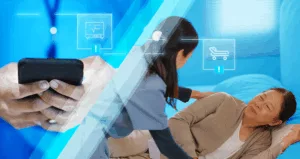To read: ~ 5 minutes
“They believe they can do it themselves, and then three days later: staff are revolting.”
This is what happens when healthcare technology vendors skip the clinical expertise and go straight to technical deployment. Implementations falter. Staff put away their devices faster than kids who’ve tired of their latest shiny new toy.
Despite billions being invested in healthcare technology, these kinds of implementation failures remain stubbornly common.
The entire healthcare technology industry is operating under a dangerous assumption—that better features and more advanced capabilities will automatically drive adoption and outcomes. This “technical-first” mindset has created a paradox where the more sophisticated our solutions become, the more likely they are to fail in real clinical environments.
The missing ingredient isn’t always better technology: it’s a better understanding of the humans who use it.

Human factors engineering (the science of designing technology around how people actually work rather than how we think they should work) offers a fundamentally different approach. Instead of asking clinicians to adapt to technology, it asks technology to adapt to clinicians. And the companies that embrace this shift are seeing better implementation, smoother adoption and a significant competitive advantage.
A Technological Tunnel Vision
Healthcare technology companies consistently develop and implement solutions without adequate understanding of how clinicians actually work under pressure. This blindspot manifests in a few critical ways:
The patient gets lost in the technology. “There is a patient, a family member, behind that technology,” explains Ericka Carter, a clinical informatics expert with over 20 years of frontline nursing experience. “Sometimes technology vendors, or even those who are building it, forget that, or miss that. And that has to come first.”
When vendors focus too much on technical specifications and integration capabilities, they lose sight of the human ecosystem that technology is meant to serve. Their solutions may work perfectly in a testing environment, but create chaos when deployed in a busy emergency department.
Clinical voices are frequently excluded from design decisions. Vendors often consult the people who will use the technology—nurses, physicians, and other frontline staff—last (or not at all) in the design process. This creates a fundamental disconnect between what technology companies think clinicians need and what actually works in high-pressure clinical environments.
“If the nurses aren’t being heard, if they are not embedded in the process, the technology will not be successful,” Carter notes. Yet most healthcare technology companies treat clinical input as optional feedback rather than essential design criteria.
The stakes are higher than most realize. Without clinical-centered design, even technically superior solutions fail rapidly—often within days of implementation. This leads to wasted implementation investments, staff frustration, and ultimately compromised patient care quality.
The timeline from deployment to failure can be shockingly short. When clinical needs aren’t understood upfront, staff resistance builds quickly, creating a cycle where technology becomes an impediment rather than an enabler of better care. Dedicated clinicians are forced to develop workarounds, creating unofficial systems and processes to navigate around the next technology that was meant to help them. These workarounds, while demonstrating the ingenuity of healthcare professionals, create additional cognitive load and safety risks.

The Case for Human-Centered Healthcare Technology
Embedding clinical expertise and human factors principles into the entire product lifecycle creates measurable competitive advantages for modern healthcare technology vendors. This approach relies on a shift in POV when it comes to implementation:
Design Philosophy for Patients and Clinicians
Companies should evaluate every technology decision through the lens of patient impact and caregiver enablement. This means starting with a fundamental question: “How does this technology help clinicians provide better patient care?”
The most successful implementations focus on workflow integration rather than workflow disruption. As Carter explains, “It’s critical for us to design technology that is going to be easy to use, efficient, and also sustainable.”
Clinical Expertise as Competitive Differentiator
Companies that embed clinical professionals in their product teams gain insights that purely technical teams miss. These clinical experts can identify problematic implementation approaches before they cause adoption failures.
“Having that clinical background, we can say, ‘We don’t necessarily recommend that. Your nurses are going to throw their phones if you do that,'” Carter observes. This kind of insight—knowing not just what technically works but what clinically works—prevents costly implementation failures.
Consider the following: at most hospitals, 10% of patients generate 80% of alerts. A purely technical solution might try to improve alert management broadly, but any seasoned clinician will tell you that targeted interventions for high-alert patients can solve much of the problem with far less complexity.

Implementation as Clinical Consulting
The most successful healthcare technology companies position themselves as clinical consultants who happen to use technology rather than technology vendors who serve healthcare. This shift changes the entire relationship dynamic.
Instead of asking, “How can we deploy this technology?” the question becomes, “How can we solve this clinical problem?” The technology becomes a tool in service of clinical outcomes rather than an end in itself.
Three Strategic Principles for Transformation
Organizations ready to make this shift can implement three core strategic principles:
1. Build Clinical Advisory Capabilities into Product Teams
Rather than treating clinical input as optional feedback, embed clinical professionals directly into product development teams. These aren’t just consultants that companies bring in for validation, they’re core team members who help shape product strategy from the ground up.
This prevents technically sound solutions from failing because they don’t account for cognitive load, workflow interruptions, or the time pressures that define clinical practice.
2. Design for Cognitive Load Reduction
Every feature should reduce rather than increase the mental effort required from clinicians. This means prioritizing information delivery: “Making sure the right information is getting to the right people at the right time and in a prioritized way.”
Understanding cognitive load is crucial because information overload leads to alert fatigue, which decreases patient safety. As healthcare systems become more integrated, the temptation to “just add that notification” increases, but clinical expertise can help identify what information truly needs immediate attention.
3. Measure Human Impact Alongside Technical Metrics
Track clinician satisfaction and workflow efficiency as primary success metrics. Technical metrics like system uptime and integration speed matter, but they fail to predict adoption success.
“A lot of times it’s just the verbal feedback of ‘Oh my, this has been so helpful.’ It is the expression of feeling less overwhelmed,” Carter explains. These human impact measures often predict long-term success better than traditional technical metrics.
An Inevitable Shift
Healthcare systems are becoming more sophisticated buyers of technology. They increasingly evaluate vendors not just on technical capabilities but on their ability to ensure successful adoption and measurable outcomes.
The industry is also grappling with increasing clinician burnout and the need for cognitive load reduction as healthcare systems prioritize staff retention. “Information overload, and I hate to say it, but alert fatigue” is becoming more common “as more systems become integrated,” Carter notes.
This creates a market opportunity for companies that can demonstrate not just what their technology does, but how it reduces burden and improves workflow for the humans who use it.
The ROI of Human-Centered Design
The companies that have embraced this approach are seeing measurable results. Take alarm management as an example: organizations implementing clinical-led approaches achieve dramatic improvements—in some cases, 43% reductions in alarm volume while maintaining or improving patient safety.
Companies like Connexall, who embed clinical expertise throughout their process, consistently work more effectively for clinical staff. This isn’t just about being nice to nurses: it’s about creating technology that actually works in clinical environments.
The Choice Ahead
The industry is at an inflection point. Clinical expertise is becoming the key differentiator, and companies that embed human factors engineering now will establish clinical partnerships that are difficult for competitors to replicate later.
The question isn’t whether this shift will happen, it’s whether your organization will move with the times or get left behind. The companies that prioritize clinical expertise will transform from technology vendors into trusted clinical partners, and that transformation will determine who survives the next phase of healthcare technology evolution.
The choice is clear: continue competing on features and specifications or start competing on human understanding and clinical outcomes.
The companies that choose the latter will discover that the best technology isn’t just technically sophisticated—it’s humanely intelligent.


